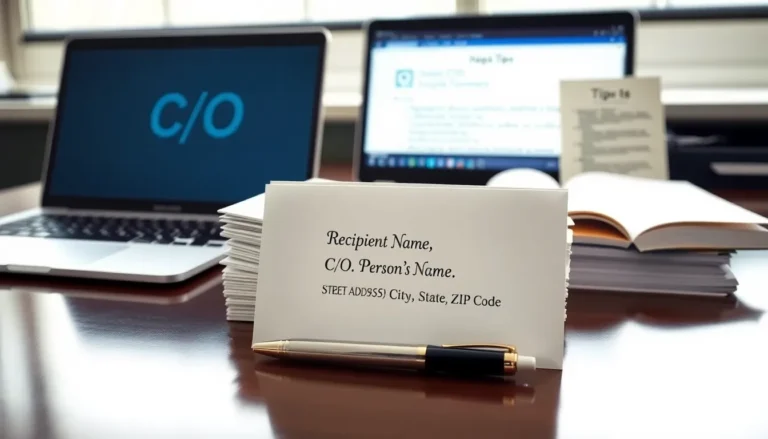Writing a business memo might seem like a straightforward task, but if you’ve ever drafted one while balancing a coffee in one hand and a deadline in the other, you know it can turn into a high-stakes juggling act. This concise yet crucial document plays a pivotal role in organizational communication. It can inspire action, inform colleagues, or even clarify policies because, let’s face it, clarity can sometimes be a distant cousin in the world of office jargon. So, whether you’re drafting a memo for the board or just trying to escape a meeting with a well-articulated note, this guide has got you covered with everything you need to know about writing an effective business memo.
Table of Contents
ToggleUnderstanding The Purpose Of A Memo

Memos are often seen as shorthand for official communication, conveying important information succinctly within a business setting. They serve various purposes: to provide updates, establish new policies, or simply keep everyone in the loop. Understanding this purpose is key: it aligns the memo’s tone, structure, and content with its intended message. When done right, a memo can save time and minimize misunderstandings.
Consider this: you wouldn’t send a letter to a friend in the same way you would address a customer. Similarly, understanding the memo’s purpose helps tailor the message effectively, ensuring the recipient knows what actions are required, or better yet, how they can avoid unnecessary confusion.
Types Of Memos
Business memos can broadly be categorized into a few types, each with its unique intent:
- Informational Memos: These provide updates on projects or policies without requiring immediate action. Think of them as your friendly neighborhood news bulletin.
- Directives: These outline specific actions that must be taken. If your boss tells you to ‘jump,’ these memos explain how high.
- Confirmation Memos: Such memos confirm discussions and decisions made in meetings, acting as a formal record. They are the ‘let’s get this in writing’ of the business world.
- Request Memos: When you need something specific from a colleague or department, a request memo will do the trick.
Knowing which type to use will ensure the memo meets its objective effectively. Each type requires a slightly different approach, but understanding these distinctions makes the task less daunting.
Memo Formatting Guidelines
Proper formatting is crucial for professionalism and readability. A business memo typically follows this structure:
- Header: This includes ‘To,’ ‘From,’ ‘Date,’ and ‘Subject.’ Clarity here serves as both an introduction and an outline of the content.
- Opening Statement: Begin with a purpose statement, informing readers why they should care.
- Body: This is where the main message resides, broken down into clearly labeled sections if necessary. Use bullet points or numbered lists for clarity.
- Closing Statement: Summarize the key points, perhaps including a call to action. This directs the reader on what to do next.
- Signature: While not always required, including a name or signature gives it that personal touch.
Each element plays a role, contributing to the overall professionalism of the memo. Following a standardized format can also make it easier for others to find or refer back to the information they need.
Writing The Memo Content
Once you have the format down, it’s time to focus on crafting the content. Good memo writing is about clarity and conciseness. Start with a strong opening statement that outlines the memo’s purpose, this keeps the reader engaged and sets expectations.
The body should be informative and to the point. Avoid overly complex sentences or jargon that could confuse the reader. Making use of short paragraphs aids readability, allowing each point to stand on its own. For example, rather than saying, “The new policy will affect all employees in various departments,” specify how it impacts each department.
Also, consider the tone of the memo. It should reflect professionalism while being conversational enough to maintain engagement. Use active voice whenever possible, as it conveys confidence and directness. Finally, be sure to recheck your grammar and punctuation: typos can undermine even the best-crafted memo.
Common Mistakes To Avoid
Even seasoned professionals can slip up when writing memos. Here are some frequent pitfalls to watch out for:
- Lack of Clarity: Ensure your message is straightforward. Ambiguity leads to confusion and unnecessary back-and-forth.
- Overloading Information: Avoid cramming too much information into the memo. This can overwhelm the reader. Stick to the core message.
- Neglecting the Audience: Adjust the tone and content to suit the recipient’s needs. A memo meant for upper management might look different from one directed to colleagues.
- Forgetting a Call to Action: Always be clear about what you want the reader to do. If there’s no call to action, the memo loses efficacy.
Eliminating these mistakes can significantly enhance the impact of your memo. Take the time to revise and ensure clarity and professionalism.
Tips For Effective Memo Writing
To take your memo writing skills from good to great, consider the following tips:
- Be Direct: Get to the point quickly: use active language and concise sentences.
- Use Bullet Points: This makes information easier to digest and highlights key points.
- Stay Relevant: Include only details that relate directly to the memo’s purpose. Irrelevant information can distract and dilute the main message.
- Encourage Feedback: Invite questions or clarification to foster open communication and collaboration.
- Stay Professional: Maintain a tone that reflects your organization’s culture while being respectful and courteous.
By incorporating these practices, memo writing can evolve from a mundane task into an effective communication tool, bolstering productivity and clarity.








